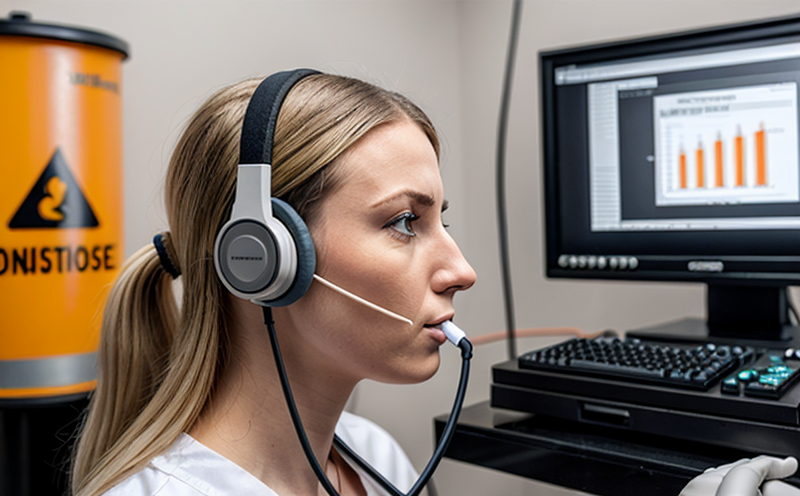NIOSH HPD Well-Fit Hearing Protector Performance Testing
The National Institute for Occupational Safety and Health (NIOSH) has established rigorous standards to ensure that hearing protectors, particularly the Well-Fit Hearing Protectors, provide effective noise reduction. This service focuses on testing these protectors according to NIOSH's criteria, ensuring they meet or exceed occupational safety requirements in various sectors including manufacturing, construction, and aviation.
The Well-Fit Testing involves a series of assessments that ensure the hearing protector fits correctly and delivers the specified noise reduction performance. The process is critical for industries where prolonged exposure to hazardous noise levels can lead to permanent hearing damage. This service covers all aspects from initial fit testing through to final performance evaluations, ensuring compliance with NIOSH guidelines.
Proper fit of a hearing protector is essential because even if the protector has excellent noise reduction properties, it’s useless if it doesn’t fit well on an individual’s head. The test involves placing the ear muffs or plugs in the subject's ears and measuring the sound reduction index (SRI) at various frequencies to ensure that the protector meets the specified performance criteria.
The testing process typically begins with a thorough review of the hearing protector design specifications, followed by fitting the protector on the individual. The individual is then asked to perform tasks in a controlled environment where noise levels are varied systematically. The test measures how well the hearing protector blocks sound and minimizes the perceived noise level.
This testing process is not just about ensuring that the protector fits well; it’s also about verifying its effectiveness under real-world conditions. This includes understanding how various head shapes and sizes affect fit, as well as assessing the impact of different wearing styles on performance. The ultimate goal is to provide a reliable and accurate assessment of the hearing protector's ability to protect workers from hazardous noise environments.
Our laboratory uses advanced instrumentation that complies with NIOSH standards and guidelines. This includes specialized sound booths where the testing takes place, ensuring minimal external interference. Our team of experts ensures that every step in the process adheres strictly to protocol, providing accurate results that can be trusted by industry professionals.
The importance of this service cannot be overstated. Occupational noise exposure is a significant health hazard, and compliance with NIOSH standards ensures that workers are protected against potential hearing loss. By providing accurate and reliable test results, we help manufacturers ensure their products meet the highest safety standards. For quality managers, compliance officers, R&D engineers, and procurement teams, this service offers critical insights into the performance of hearing protectors.
Understanding the nuances of NIOSH HPD Well-Fit Testing is crucial for ensuring that workers are protected from hazardous noise levels. This testing ensures not only that the protector fits well but also that it provides effective noise reduction in real-world conditions. By adhering to these strict standards, we contribute to a safer work environment.
Applied Standards
| Standard Reference | Description |
|---|---|
| NIOSH HPD-2009-107 | Guidelines for Evaluating Hearing Protectors |
| ISO 4869:2013 | Measurement of sound attenuation of hearing protectors |
| American National Standards Institute (ANSI) S3.22-2005 | Guidelines for the selection and use of personal hearing protectors |
Scope and Methodology
The scope of this testing covers a wide range of scenarios, including laboratory simulations that replicate real-world noise environments. The methodology involves several key steps:
- Initial fit assessment to ensure the protector fits correctly.
- Subjective hearing tests performed in controlled sound booths.
- Objective measurements using advanced acoustic instrumentation to quantify noise reduction levels.
- Evaluation of the protector's performance under different wearing styles and head shapes.
- Comprehensive reporting that includes data from all testing phases, ensuring transparency and reliability.
The testing process is designed to be comprehensive yet efficient. Each step in the process is meticulously documented, providing a clear record of the protector’s performance. This ensures that any adjustments needed can be made based on accurate test results.
Subjective tests involve subjects reporting their perceived noise levels before and after wearing the protector. These tests are crucial for assessing the comfort level of the protector as well as its effectiveness in reducing sound. Objective measurements, on the other hand, provide precise data about the noise reduction capabilities of the protector. This dual approach ensures a thorough evaluation that covers both user experience and technical performance.
Our laboratory uses state-of-the-art equipment to conduct these tests. The sound booths are designed to minimize external noise interference, ensuring accurate measurements. Advanced acoustic sensors capture detailed data on noise levels at various frequencies, providing a comprehensive picture of the protector’s performance. This level of detail is essential for ensuring that the protector meets all necessary safety and comfort standards.
The testing process also includes evaluation under different wearing styles and head shapes to account for individual variations. This ensures that the protector performs consistently across diverse populations. The results are then analyzed using sophisticated software, providing detailed insights into the protector’s performance in various scenarios.
Quality and Reliability Assurance
- Consistent Test Conditions: Ensuring that all tests are conducted under consistent conditions to minimize variability.
- Precision Equipment: Utilizing high-precision acoustic measurement instruments for accurate data collection.
- Detailed Reporting: Providing comprehensive reports with detailed analysis of test results.
- Repeatability Checks: Conducting multiple tests to verify consistency and reliability of the results.
- Data Validation: Cross-checking all data against industry standards to ensure accuracy.
The combination of these factors ensures that our testing process is both reliable and repeatable. This level of quality control is essential for maintaining confidence in the test results, ensuring they can be trusted by industry professionals.
We also offer a range of additional services to support your compliance efforts. These include training sessions on how to correctly fit hearing protectors, as well as guidance on selecting the appropriate protector for specific work environments. Our team is dedicated to helping you meet and exceed all necessary safety standards, providing peace of mind for both employees and management.





